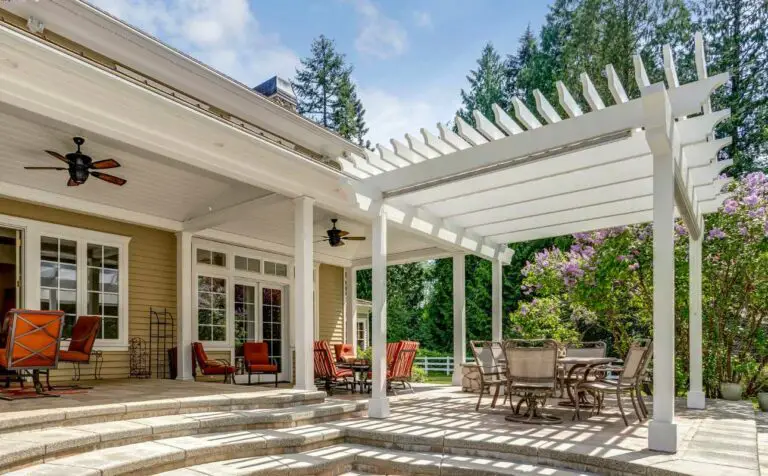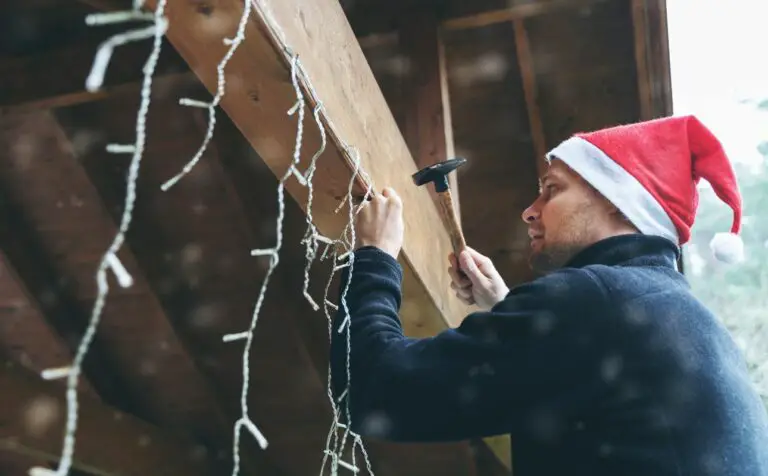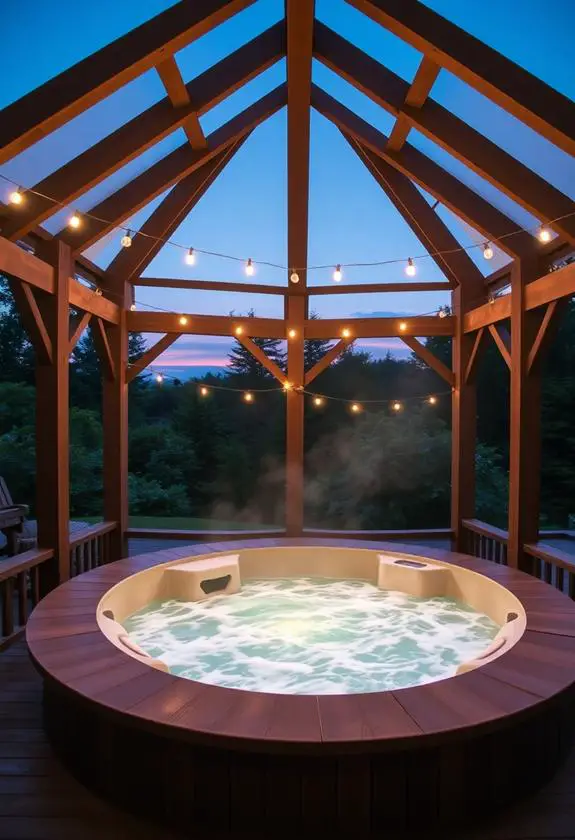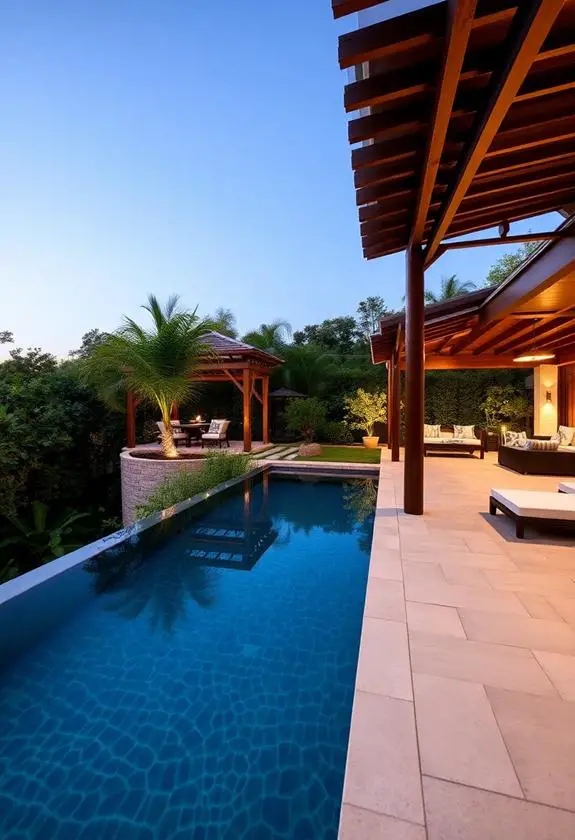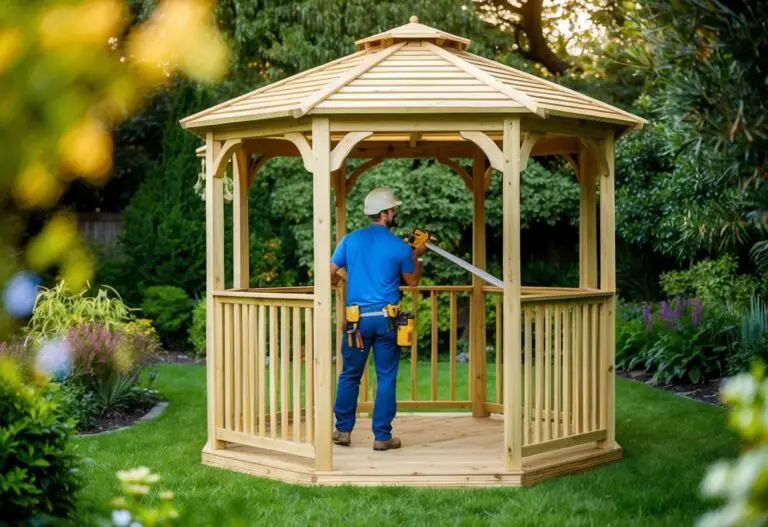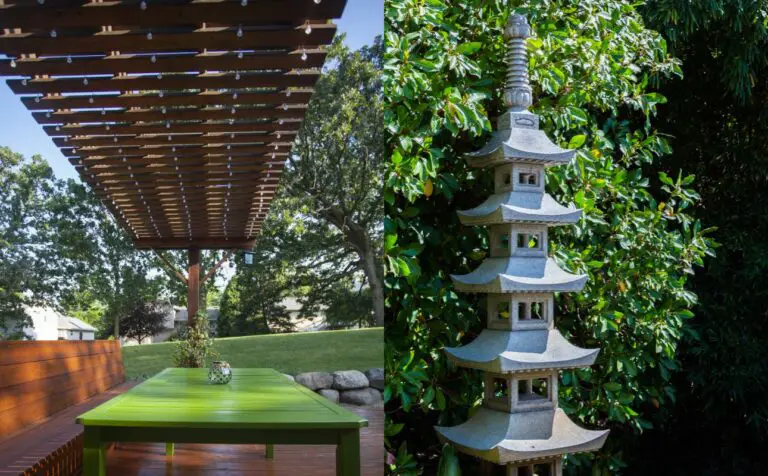Have you ever wondered what materials are used to make Adirondack chairs? Well, let’s take a closer look!
Adirondack chairs can be made out of various materials, such as wood, metal, and even recycled plastic.
For example, some Adirondack chairs are crafted from beautiful and durable wood like hemlock, cedar, teak, or oak. These sturdy wooden chairs not only offer a timeless aesthetic but also provide excellent durability in outdoor environments.
On the other hand, you can also find Adirondack chairs made from metal materials like aluminum, steel, or wrought iron, which offer a more modern and sleek look.
So, whether you prefer the natural charm of wood or the contemporary appeal of metal, there’s an Adirondack chair out there to suit your style and needs.
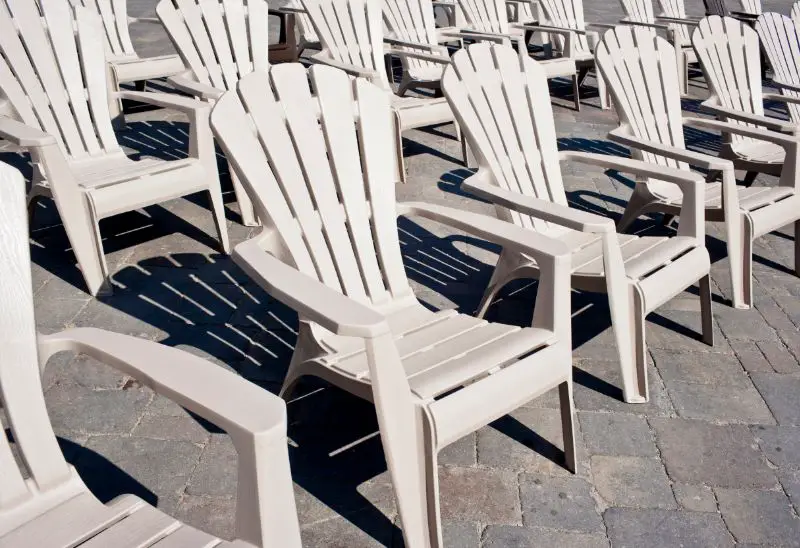
Wood
Wood is the most traditional and popular material for Adirondack chairs, offering a natural beauty that enhances any outdoor space.
Hemlock, cedar, teak, oak, and pine are some of the commonly used types of wood in crafting these chairs.
Each wood type has its own unique characteristics, such as color, grain, and weather resistance, allowing you to choose the one that best suits your preferences and needs.
Hemlock
Adirondack chairs are often made out of hemlock wood due to its light color, fine texture, and straight grain. Hemlock wood offers several advantages for chair construction:
- Strength: Hemlock wood is known for its strength and durability, making it suitable for outdoor furniture that can withstand the elements.
- Stability: The straight grain of hemlock wood prevents warping and twisting, ensuring that the chairs remain sturdy and comfortable.
- Affordability: Hemlock wood is relatively inexpensive compared to other hardwoods, making it a cost-effective choice for manufacturing Adirondack chairs.
However, there are also some disadvantages to using hemlock wood:
- Susceptibility to rot: Hemlock wood is prone to rotting if not properly treated and maintained.
- Insect vulnerability: Without proper treatment, hemlock wood can attract insects and pests.
- Treatment methods: Hemlock wood requires regular treatment with protective finishes to enhance its longevity and resistance to the elements.
In terms of sustainability, hemlock wood is considered a sustainable choice as it’s typically harvested from managed forests. However, it’s important to ensure that the wood is sourced responsibly to minimize environmental impact.
Cedar
Cedar is another popular choice for making Adirondack chairs due to its unique characteristics and benefits.
One of the advantages of cedar wood is its exceptional durability. Cedar is naturally resistant to decay, insects, and moisture, making it an ideal material for outdoor furniture. It can withstand harsh weather conditions without deteriorating quickly.
Additionally, cedar wood ages gracefully, developing a beautiful silver-gray patina over time.
However, there are a few drawbacks to consider. Cedar has a tendency to crack, split, and fade if not properly maintained. Regular sealing or staining is essential to protect the wood and maintain its appearance.
In terms of cost, cedar chairs are typically more expensive than chairs made from hemlock. However, considering its durability and longevity, cedar chairs can be a worthwhile investment.
Teak
Teak is a popular choice for crafting Adirondack chairs due to its unique qualities and advantages. Here are three reasons why teak wood is highly sought after:
- Advantages: Teak wood is known for its exceptional durability and stability, making it perfect for outdoor furniture like Adirondack chairs. It has a high oil content that helps it withstand harsh weather conditions, such as rain, heat, and UV rays. Additionally, teak wood retains its shape and color over time, ensuring that your Adirondack chairs will stay beautiful and functional for years.
- Disadvantages: While teak wood offers numerous benefits, it does come with a few drawbacks. One major disadvantage is its high cost. Teak wood is considered a luxury material, and its limited availability contributes to its hefty price tag. Additionally, teak wood is quite heavy, making it challenging to move around or transport.
- Maintenance and Cost: To maintain the natural beauty of teak wood Adirondack chairs, regular cleaning and oiling are necessary. This helps to prevent the wood from drying out and keeps it looking fresh and vibrant. However, the cost and effort required for maintenance are worth it considering the longevity and elegance that teak wood brings to your outdoor space.
Given its advantages and timeless appeal, it’s no wonder that teak wood is a popular choice for crafting Adirondack chairs.
Oak
When considering the materials used to make Adirondack chairs, one option to explore is oak wood. Oak wood is known for its light to dark brown color, coarse texture, and prominent grain.
There are several advantages of using oak wood for Adirondack chairs. First, oak wood is extremely hard and strong, making it durable and long-lasting. It is also a versatile material that can blend well with different furniture styles.
However, oak wood has its disadvantages as well. It is vulnerable to rot, insects, and fungi if not properly treated or coated. To maintain oak wood Adirondack chairs, regular cleaning and occasional re-staining are recommended.
When staining oak wood, it is important to choose the right technique to enhance its natural beauty. In comparison to other hardwoods, oak wood stands out for its strength and versatility.
| Advantages | Disadvantages |
|---|---|
| Hardness | Vulnerable to rot, insects, and fungi |
| Strength | Requires proper treatment and coating |
| Versatility | |
| Blends well with other furniture styles | |
Pine
To explore the materials used to make Adirondack chairs, let’s now discuss the versatility and characteristics of using pine wood. Pine wood is a popular choice for furniture due to its unique features and affordability. Here are three reasons why pine wood is commonly used:
- Advantages of using pine wood in furniture:
- Low cost and easy availability
- Light weight, making it easy to move around
- Ability to be painted or stained in various colors
- Disadvantages of using pine wood in furniture:
- Low durability and susceptibility to damage
- Poor resistance to weather and insects
- Tendency to warp and crack if not protected or maintained well
- Tips for protecting and maintaining pine wood furniture:
- Regularly clean with a mild soap and water solution
- Apply a protective finish or sealant to prevent moisture damage
- Keep furniture away from direct sunlight to avoid fading
While pine wood has its advantages, it may not be suitable for all outdoor furniture. Alternatives to pine wood for outdoor use include teak, cedar, and eucalyptus.
Plastic
Plastic is another popular material for Adirondack chairs because of its convenience and variety. There are different types of plastic used, such as resin, polyethylene, and polywood, each with their own characteristics and benefits.
These plastics come in various colors, textures, and weights, and can be recycled, low maintenance, and cost-effective options for outdoor furniture.
Resin
Adirondack chairs can be made out of resin, a versatile material with a smooth and glossy surface. Here are some things you should know about resin Adirondack chairs:
- Advantages:
- Low cost and easy availability make resin chairs a budget-friendly option.
- Resin is lightweight, making it easy to move around and store.
- Resin chairs resist fading, cracking, and peeling, ensuring long-lasting use.
- Disadvantages:
- Resin chairs may lack the quality and comfort of other materials.
- Over time, resin can become brittle and discolored, affecting its appearance and durability.
- Resin chairs may not provide the stability you desire.
Maintenance Tips:
- Clean resin chairs with mild soap and water.
- Avoid using abrasive cleaners or brushes that could scratch the surface.
- Store chairs indoors or cover them during harsh weather conditions.
Different Colors:
- Resin chairs come in a variety of colors, allowing you to choose the perfect one to match your outdoor decor.
Polyethylene
When considering the material used in Adirondack chairs, it’s important to explore the benefits and drawbacks of polyethylene plastic.
Polyethylene, a type of plastic, offers several advantages for outdoor furniture. It is highly durable, flexible, and resistant to extreme temperatures, moisture, and UV rays. These qualities make polyethylene chairs a popular choice for outdoor use.
However, there are also some disadvantages to consider. Polyethylene chairs can be costly, and the material is not as readily available as other options. Additionally, polyethylene is difficult to recycle or dispose of, which can have negative environmental impacts.
Overall, polyethylene chairs require minimal maintenance and offer long-lasting comfort, but their sustainability may be a concern.
| Advantages | Disadvantages | Uses | Maintenance |
|---|---|---|---|
| – Durable and flexible | – High cost | – Outdoor furniture | – Easy to clean |
| – Resistant to extreme temperatures, moisture, and UV rays | – Limited availability | – Poolside chairs | – No special treatment required |
| – Comfortable | – Heavy weight | – Patio chairs | – Occasional washing with soap and water |
| – Long-lasting | – Difficult to recycle or dispose of | – Garden chairs | – Store indoors during harsh weather |
This table provides a clear overview of the advantages, disadvantages, uses, and maintenance of polyethylene chairs.
Polywood
Polywood is a popular choice for constructing Adirondack chairs due to its ability to mimic the look and feel of wood while offering the benefits of plastic. Here are some key points to consider about polywood:
Advantages of polywood:
- Durability: Polywood is highly resistant to fading, warping, splintering, and rotting, making it a long-lasting option for outdoor furniture.
- Sustainability: Polywood is made from recycled plastic, reducing waste and promoting eco-friendly practices.
- Elegance: With its wood-like appearance, polywood offers a classic and sophisticated look to Adirondack chairs.
Disadvantages of polywood:
- High cost: Polywood chairs can be more expensive than their wooden counterparts.
- Limited variety: Polywood chairs come in a limited range of colors and styles compared to wood.
- Maintenance: While polywood requires less maintenance than wood, occasional cleaning and polishing are still necessary.
When comparing polywood to wood, it’s important to consider factors such as cost, durability, and environmental impact. Polywood offers a sustainable alternative to wood, with its recycled plastic construction and resistance to weathering.
Metal
When it comes to metal Adirondack chairs, you have several options to choose from: aluminum, steel, and wrought iron.
Each type has its own unique characteristics and benefits.
Aluminum is lightweight, rust-resistant, and easy to maintain, while steel offers durability and strength.
Wrought iron, on the other hand, is known for its classic and elegant look.
Aluminum
Adirondack chairs can be made out of aluminum, a lightweight and rustproof material that offers various advantages. Here are some key points to consider when it comes to aluminum Adirondack chairs:
- Advantages and drawbacks: Aluminum chairs are lightweight, making them easy to move around and transport. They’re also rustproof, ensuring long-lasting durability. However, aluminum chairs may not be as comfortable as other materials due to their lack of cushioning.
- Maintenance requirements: Aluminum chairs require minimal maintenance. They can be easily cleaned with soap and water, and their powder-coated or painted finish helps protect against fading and corrosion.
- Different styles and designs: Aluminum Adirondack chairs come in a variety of styles and designs. They can be found in classic, traditional, and modern designs, allowing you to choose one that suits your personal taste and outdoor decor.
Steel
Steel is a durable and strong material commonly used in the construction of Adirondack chairs. One of the main advantages of steel is its high durability, which makes it resistant to wear and tear, impact, and weight.
Additionally, steel can undergo a galvanization process, which involves coating it with a layer of zinc to enhance its corrosion resistance. This makes steel chairs less likely to rust or corrode compared to other metals.
When it comes to maintenance, steel chairs require minimal upkeep. Simply cleaning them regularly with mild soap and water can help keep them in good condition.
However, it’s important to note that steel chairs can still be prone to scratches and chipping, so it’s best to avoid dragging them across rough surfaces.
Wrought Iron
One popular material for crafting Adirondack chairs is wrought iron, which has been used for centuries in various applications. Wrought iron is known for its hard and ornamental nature, making it perfect for creating intricate designs and patterns.
Here are some key points to consider about wrought iron chairs:
- Wrought iron vs. cast iron: Understanding the differences: Wrought iron is forged, while cast iron is melted and poured into molds. Wrought iron is more malleable and has a higher carbon content, making it stronger and more durable.
- The durability of wrought iron furniture for outdoor use: Wrought iron chairs are highly durable and can withstand various weather conditions, making them perfect for outdoor use. They’re resistant to rust and corrosion, but regular maintenance is necessary.
- How to maintain and protect wrought iron chairs from rust and corrosion: To prevent rust and corrosion, it’s important to regularly clean and seal wrought iron chairs. Apply a protective coating of paint or sealant, and keep them dry to avoid moisture buildup.
Wrought iron chairs are available in a wide range of designs and patterns, from classic to contemporary. They add a timeless and elegant touch to any garden or patio, making them a popular choice for outdoor seating.
Frequently Asked Questions
Are Adirondack Chairs Suitable for Outdoor Use?
Adirondack chairs are perfect for outdoor use. They offer great outdoor durability and weather resistance. You’ll love their low maintenance requirements. They come in various material options and color choices.
Can Adirondack Chairs Be Folded for Easy Storage?
Yes, Adirondack chairs can be folded for easy storage. They have folding mechanisms and space-saving designs that make them portable and offer compact storage solutions. They are easy to store and convenient.
What Is the Weight Capacity of Adirondack Chairs?
The weight capacity of Adirondack chairs depends on the material used. They are designed for outdoor durability and can withstand various weather conditions. The folding mechanism allows for easy winter storage.
Are Adirondack Chairs Comfortable Without Cushions?
Adirondack chairs are comfortable even without cushions due to their ergonomic design. They provide ample support and relaxation. However, cushion options are available for added comfort. The durability factor is high, and maintenance requirements are minimal. Adirondack chairs can be made from natural wood or synthetic materials.
Can Adirondack Chairs Be Left Outside During Winter Months?
During winter months, it’s important to properly care for your adirondack chairs. Consider durable materials like teak or polywood, which are weatherproof. Maintain them by cleaning regularly and store them in a protected area when not in use.
